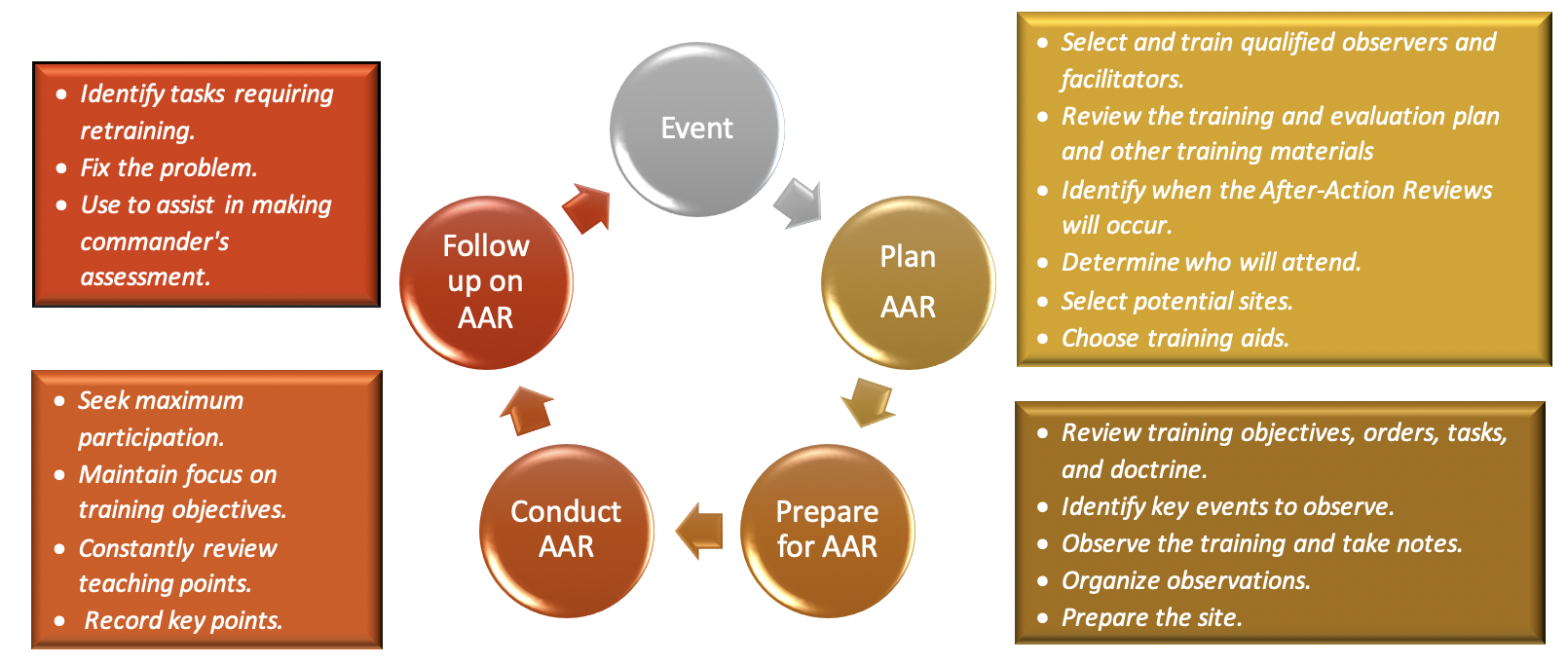
Hello, my name is Stephen Axelrad – the founder and chair of the Military and Veteran Evaluation Topical Interest Group. This post is dedicated to the After-Action Review, a formative evaluation technique that has its origins in the military but can be applied in many different contexts.
Military Origins
The After-Action Review is a process and technique the U.S. Army developed to help Soldiers perform and improve operations in deployment settings. The U.S. Army defines an AAR as:
A professional discussion of an event, focused on performance standards, that enables Soldiers to improve on weaknesses. It is a tool leaders and units can use to get maximum benefit from every mission or task.
The U.S. Army spends a lot of time and resources in training and planning Soldiers for different missions. The U.S. Army’s high-risk, highly variable missions dictates that no amount of training or planning can prepare Soldiers for all possible scenarios in combat, peacekeeping, and humanitarian operations. After-Action Reviews can take on many forms but proceed according to four core steps that follow one event and precede a new event.

Universal Applications
The After-Action Review is a flexible process and tool that can work well in settings beyond military operations. The After-Action Review encourages leaders and staff to pause, reflect, and improve – all of which evaluators try to encourage during their evaluations. For Commanders and Soldiers in a combat zone, the After-Action Review enables them to assess how well their plans and training work in real missions. For leaders and staff in civilian settings, the pause-reflect-improve stance that After-Action Reviews encourage are effective for programs that have a significant event, milestone, or initiative as critical outputs, which requires the coordination of many individuals and resources over a few days or weeks. After-Action Reviews allow evaluators to insert themselves in program planning and implementation activities that adds value for leaders and staff. The range of situations that can benefit from After-Action Reviews include:
- Emergency responses to natural or manmade disasters
- Multi-day conference or training workshops
- Off-site planning meetings
- Task forces
- Outreach campaigns
Lesson Learned:
After Action Reviews are extensions of good program planning and implementation. After-Action Reviews encourage evaluation use because leaders and program staff can test evaluation findings during implementation. The most effective After-Action Reviews flatten the hierarchy. In the U.S. Army, After-Action Reviews are moments when a Corporal’s opinion matters as much as a Sergeant’s or Captain’s. In civilian settings, position titles should not matter and the facilitator and observer should have the same authority as individual participants.
Rad Resources:
If you’re more interested in learning more, I encourage you to read the remaining posts of this week, join our TIG via the AEA web site, and contact me at stephen.h.axelrad@gmail.com.
The American Evaluation Association is celebrating Memorial Week in Evaluation. The contributions this week are from members of the Military and Veteran Evaluation TIG featuring contributions to evaluation with military origins but relevant to all we do. Do you have questions, concerns, kudos, or content to extend this aea365 contribution? Please add them in the comments section for this post on the aea365 webpage so that we may enrich our community of practice. Would you like to submit an aea365 Tip? Please send a note of interest to aea365@eval.org . aea365 is sponsored by the American Evaluation Association and provides a Tip-a-Day by and for evaluators.

Thank you for sharing this!! In a previous position, the program had several Vietnam Veterans on staff who brought the AAR concept to our work. This is where I was first introduced to AAR’s and as a program evaluator totally embraced the technique. When I left the program, this is one of the techniques that I kept in my toolbox and continue to use throughout my work.